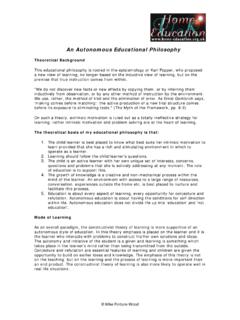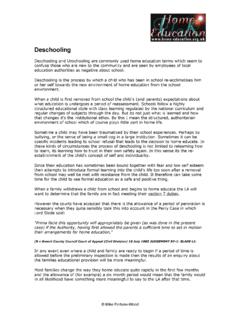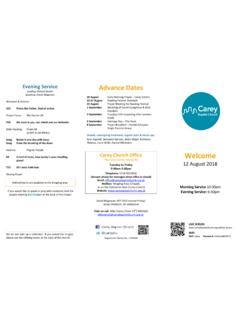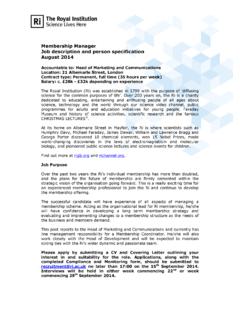Transcription of Home Education and the Safeguarding Myth: …
1 Home Education and the Safeguarding Myth: analysing the Facts Behind the Rhetoric. Wendy Charles-Warner, February 2015. Abstract Recent reports have described home educated children as invisible and isolated'. leading to Safeguarding risks. The NSPCC recently published a report which used Serious Case Reviews in which home Education was cited as a key factor', to support their call for monitoring of home educated children . This call has been taken up by the Chair of the Association of Elective Home Education Professionals, a group of Local Authority staff, to further the agenda of introducing such monitoring. This research uses information provided by 132 Local Authorities in England, in response to Freedom of Information requests, to analyse the comparative levels of Safeguarding risk in children aged 0-4 years, children aged 5-16 at school and home educated children .
2 Home educated children were found to be disproportionately scrutinised, being approximately twice as likely to be referred to Social Services at , as were children aged 0-4 years at and children aged 5-16 who attend school at Despite that double referral rate, Child Protection Plans were in place for only - of home educated children compared to of all 0-4 year olds and of 5- 16 year old schooled children . Referrals to Social Services were found to be - 5 times less likely to lead to a Child Protection Plan with home educated children than with referrals of schooled children aged 5-16 at and 5 - 7 times less likely to lead to a Child Protection Plan than referrals for children aged 0-4 years at Rates of home educated children subject to a Child Protection Plan at - of the population, were also found to be less than teaching staff guilty of abuse offences Home educated children are found to not be at increased Safeguarding risk, rather they are shown to be at lower risk than other children .
3 Analysis of the Serious Case Reviews cited by the NSPCC as having home Education as a key factor', demonstrate that all of the children involved were known to professionals and that there were multiple missed opportunities to act on concerns expressed by professionals, in each case. 1. Introduction In recent years, the spotlight has shone on those who choose to fulfil their duty1 to educate their children , by home educating them. This has primarily focussed on Safeguarding and stems from the pre 2010 Labour government's state interventionist agenda'2. That drive held Education central to the need to detect and prevent risk of harm to children3. In 2009 it led to the Badman Review' of home education4, informing the children , Schools and Families Bill (2009), Schedule 1, which sought to introduce wide reaching controls of home Education .
4 The subsequent media frenzy of allegations that home Education was a cover for child abuse, generated much public attention, leading to lobbying against the Bill by home educating families and their supporters. That section of the Bill was abandoned during the pre-general election rapid legislation sessions, otherwise known as the Wash Up'. Home educating parents are not required to register their children with their Local Authority and there is no power within the relevant Guidance to inspect or monitor their educational provision5. A consequence of this is that children who have never attended school, and are therefore not notified to the LA as having been removed from a school, are often considered invisible' by Local Authority Education staff, who frequently confuse them with children missing from Education ' 6.
5 Serious Case Reviews (SCRs), which are instigated when a child is seriously harmed or dies and such harm or death is considered to have potentially been preventable by the intervention of outside agencies, help to fuel media furore over invisible' children , slipping through the safety net of government intervention, due to not being seen by Education professionals7. A 2011 report8 examining 67 SCRs including three where home Education was mentioned, concluded that home Education was a contributing 1. See The Education Act 1996 2. Mukwamba Sendall, F (2014) How do Extreme Cases of Child Abuse Drive the Child Protection Lens. Unpublished. 3. Warin, J. (2009) Safeguarding children through Parenting Support: How Does Every Parent Matter?
6 ; in Broadhurst, K. Grover, C. & Jamieson, J. ed: (2009) Critical Perspective on Safeguarding children ; Chichester, UK, Wiley Blackwell. 4. Badman, G. (2009) Report of the Secretary of State on the Review of Elective Home Education in England, Norwich, TSO. 5. See DCSF (2007) Elective home Education : Guidelines for local authorities. [Online] Available from: tive%20home% 6. Ibid 2. 7. See for example Allen, F. (2011) Out of school, out of sight. TES connect. [Online] Available from: 8. OFSTED (2011) The voice of the child: learning lessons from serious case reviews: A thematic report of Ofsted's evaluation of serious case reviews from 1 April to 30 September 2010, Manchester, OFSTED [Online]. Available from: serious-case-reviews-a-thematic-report-o f-ofsteds-evaluation-of-serious-case-rev iews-from-1-april-to-30- september-2010/.
7 2. factor in each of the three. However, in all three cases, the children were known to Social Services prior to being removed from school and failure to apply existing legislation was apparent9, leading to suggestions that much of the fear surrounding home Education and Safeguarding , stems from lack of understanding of existing powers and legislation10 and in some cases a lack of willingness to use those powers appropriately. In 2014 the NSPCC11 fuelled the debate by suggesting that tighter controls are required for home educating families, to safeguard their children as there is a risk that home educated children can become invisible to the authorities'. This suggestion stems from their analysis of seven SCRs where home Education is mentioned.
8 This study examines the facts of each case, to ascertain whether home Education was a causal factor leading to abuse of those children . Most recently, the Safeguarding agenda has been adopted by a group of Local Authority Education staff forming the Association of Elective Home Education Professionals' (AEHEP). The Association excludes home Education charity delegates, established advisors and established home Education practitioners, who could be legitimately described as the professionals' in home Education matters. Freedom of information requests12 made in respect of the Association's correspondence with the Department for Education , reveal disdainful comments about those who currently support, inform and liaise with home educators, together with a strong movement to lobby for increased Safeguarding of home educated children , who are described as invisible' and at risk'.
9 Lack of academic evidence with respect to the true prevalence of abuse in home educating families has made it difficult to ascertain whether the claimed Safeguarding risks are based on fact or misperception13. This research aims to address that gap in the available information by providing a comparative analysis of data for children aged 0-4 years, schooled children aged 5-16 years and home educated children aged 5-16 years. 9. Ibid 2. 10. Fortune Wood (2010) quoted in Mukwamba Sendall, F (2014) How do Extreme Cases of Child Abuse Drive the Child Protection Lens. Unpublished 11. NSPCC (2014). children Not Educated in School Learning From Case Reviews: Summary of Risk Factors and Learning for Improved Practice Around Elective Home Education .
10 [Online] Available from: Education /#. 12. Nicholson, F (2014) What do they Know: Correspondence from DfE to LAs about Home Education . [Online]. Available from: 13. Ibid 2. 3. Methods The research aimed to obtain numerical data relating to child abuse in England. Statistical analysis has already been undertaken for Wales14, where Education is a devolved issue. For that reason only English data is used. All 152 Local Authorities in England were sent a Freedom of Information request (FOI), seeking data relating to number of unique referrals to Social Services during the last year for which data was available, by age of the individual child referred. Together with number of new Child Protection plans (CPP) entered into during that year and, for the 5-16 year olds, that data to be broken down by whether the child was home educated or at school.



